Having won 12 of a total of 17 matches in the Liga MX Apertura first phase, Club América topped the table and headed into the knockout rounds as the heavy favourites.
The Águilas lost just three matches all season and in the two-legged quarter-final, came up against the eighth seed in Puebla who had won merely four matches. The quarters were a breeze for the Mexican giants who easily disposed of Puebla 11-2 on aggregate.
With sixth-placed Toluca next up in the semi-finals, it looked as though progression to the final would be easy for América. However, it turned out to be anything but.
In the first leg at home, Toluca were 2-1 victors in what was an incredibly frustrating night for Fernando Ortiz’s side. Nevertheless, in front of their own fans at the Aztec Stadium in Mexico City, América had an opportunity at redemption and to turn the tie on its head.
Unfortunately, while Ortiz’s men weren’t beaten at their own stomping ground in the 1-1 draw, they couldn’t find the extra goal to level the tie on aggregate, falling to Toluca who were subsequently thrashed 8-2 across both legs in the final to winners Pachuca.
Their quest to be Apertura champions ended in dismal doom and questions were being asked of the manager after such a promising league campaign.
Let’s take a look at why Mexico’s biggest club fell at the penultimate hurdle against a much weaker side on paper. This tactical analysis piece will be a scout report of the predictable tactics used by Ortiz, as well as an analysis of what led to the side crashing out of the final phase in an unexpected fashion.
Formations
Ortiz never had to be overly flexible with the formations he would use. Club América arguably possess the best squad in Mexican football and were winning the vast majority of their league matches, meaning that the manager rarely had to bend to the will of the opposition.
For the most part, Ortiz set the Eagles up in a 4-4-2 formation this season but rotated between the conventional shape and a 4-2-3-1, replacing one of the centre-forwards with a number ‘10’ in an attempt to get more creativity between the lines.
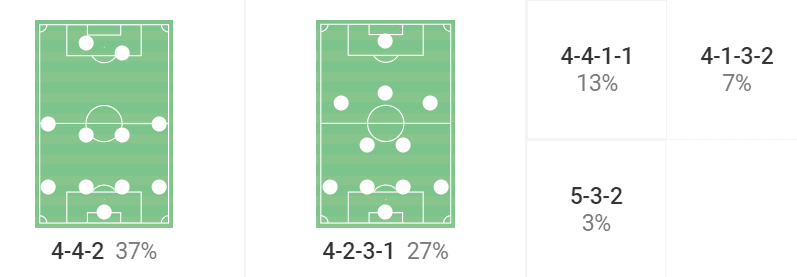
There were even a few occasions where América structured themselves close to a diamond with a 4-1-3-2 as well as a 5-3-2 to be less permeable from a defensive point of view.
Again, América haven’t used a great variety of shapes in the Apertura but didn’t really need to, given that they were the dominant side in Mexico’s top-flight division.
Nonetheless, being predictable with the choice of formation isn’t a problem as there are a plethora of top sides in world football that play within the same framework in every match, such as Manchester City, Real Madrid and Liverpool. Having the best players allows managers this privilege.
A problem comes when a side constantly attack in the same manner within their regular structure. Predictability becomes apparent which is something that Liverpool are suffering from this season. In the semi-final of the Apertura final phase, Club América endured a similar fate. Let’s look at why.
Cross after cross after cross
The key feature for Club América in their two games against Toluca in the semi-finals was crossing. Ortiz was hell-bent on creating space for the fullbacks to whip balls into the box.
At one point in the second leg at home to the eventual winners, the game became very reminiscent of Manchester United’s 2-2 draw with René Meulensteen’s Fulham in 2014 when David Moyes was in the dugout at Old Trafford.
81 crosses were attempted that day by the Red Devils which has been the highest volume of deliveries seen in a Premier League bout from one side since 2006. There was no plan B and the predictability of each attack from the then-league champions became nauseating for supporters watching in the great gallery and on the television at home.
While placing the Apertura semi-final at the Aztec Stadium on par with United’s tie eight years ago may be slightly exaggerative, América did whip a total of 47 crosses into the penalty area against Toluca, which includes 11 deep completed crosses and 36 regular crosses from the flanks.
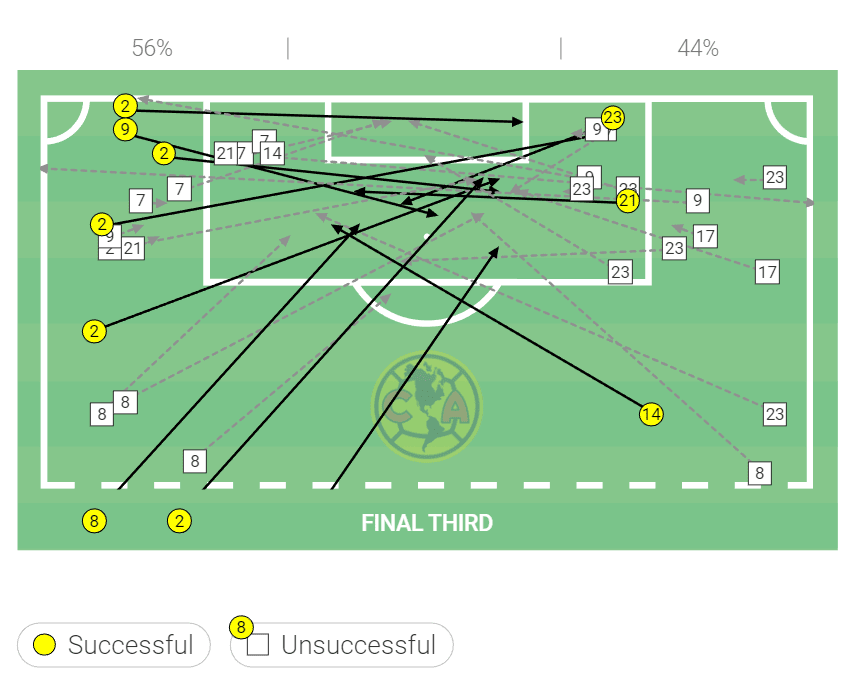
This data visual plots each of the 36 deliveries from the wide areas that América lofted into the penalty box. What is evident is how much variety the Mexican giants had in terms of their crosses.
Some balls were played just inside the opposition’s half, a few came from the byline, while many originated inside the area. Nonetheless, Ortiz’s side ended the second leg with an accuracy of merely 30.56 percent and an overall xG of 0.84.
Putting this into further context, Toluca boasted an xG of 1.02 despite having just 36.05 percent of the ball and only half the number of shots compared to the hosts on the night.
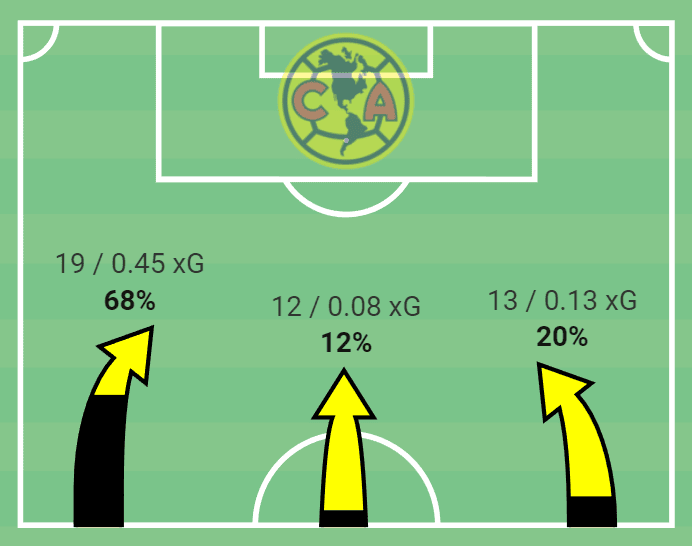
It was obvious from each direction of the Águilas’ positional attacks that playing wide was a tactical instruction from the sideline as 32 of América’s positional attacks came down the flanks.
But having such a vast quantity of crosses means that there must have been quite a lot of space for the favourites to attack into down the sides, and there was. However, this room was created by América’s tactical set-up.
Ortiz centrally overloaded Toluca’s defensive block. In turn, this narrowed the winners as there were more players to mark inside the structure. América deployed the exact same tactics in the first leg too.
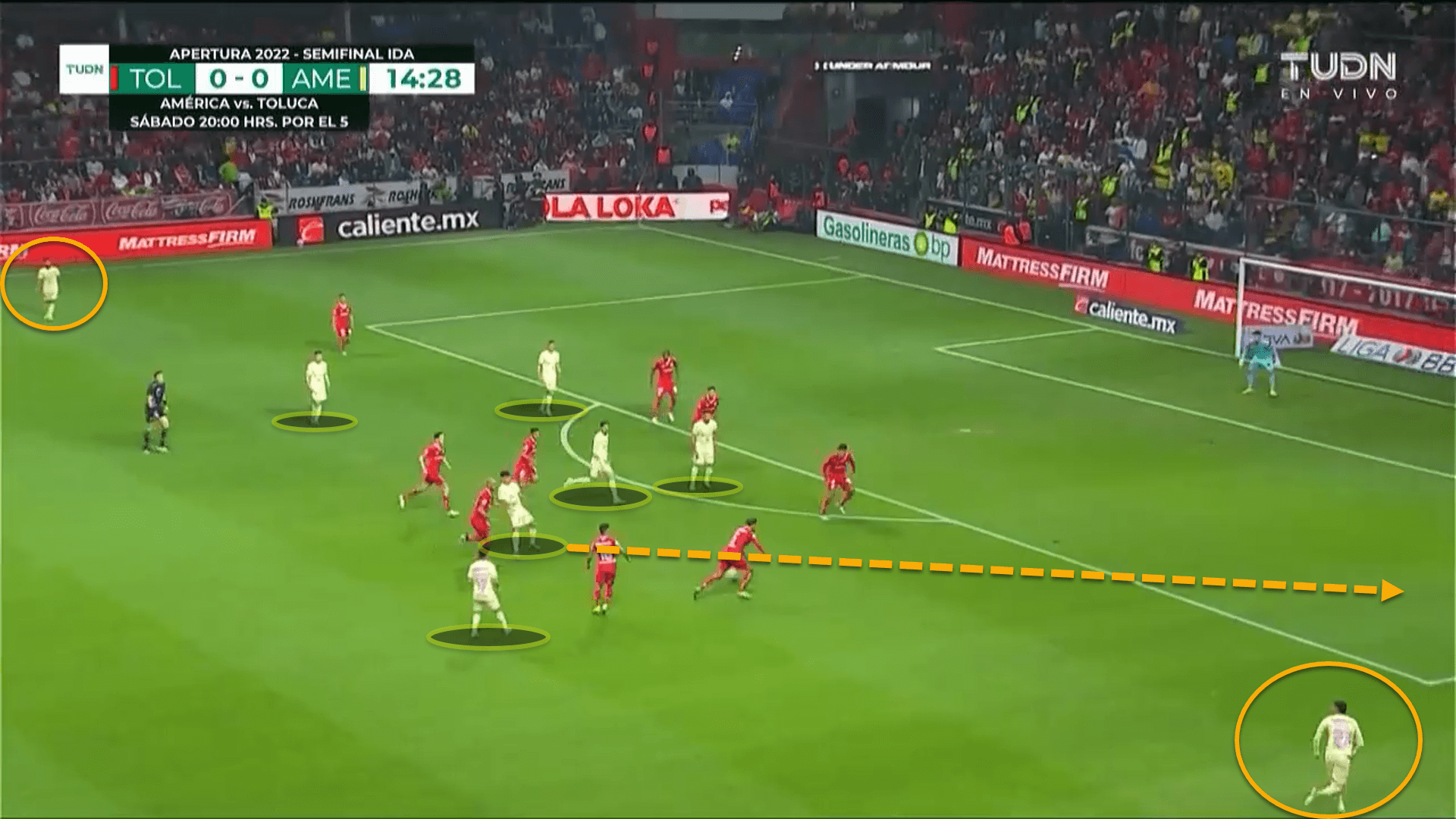
Here, América have six players positioned near Toluca’s box, with five sitting in between the lines. A quick ball into one of these five men caused alarm bells to ring for Ignacio Ambríz’s Toluca as the defensive block compacted instantly.
When this occurred, there was a plethora of space out on the flanks, with both of América’s fullbacks waiting to receive the ball. A perfectly-weighted first-time pass set Emilio Lara away with plenty of time while América already had several players in the middle ready to make darting runs into the six-yard box to get on the end of a cross.
Unfortunately, as became the theme throughout both knockout rounds versus Toluca, the opposition cleared it away with ease.
América were warned earlier in the season when Toluca came to town. In a preview of what was to come, Ambríz’s team set up in a low defensive block, again denying space between the lines for the hosts.
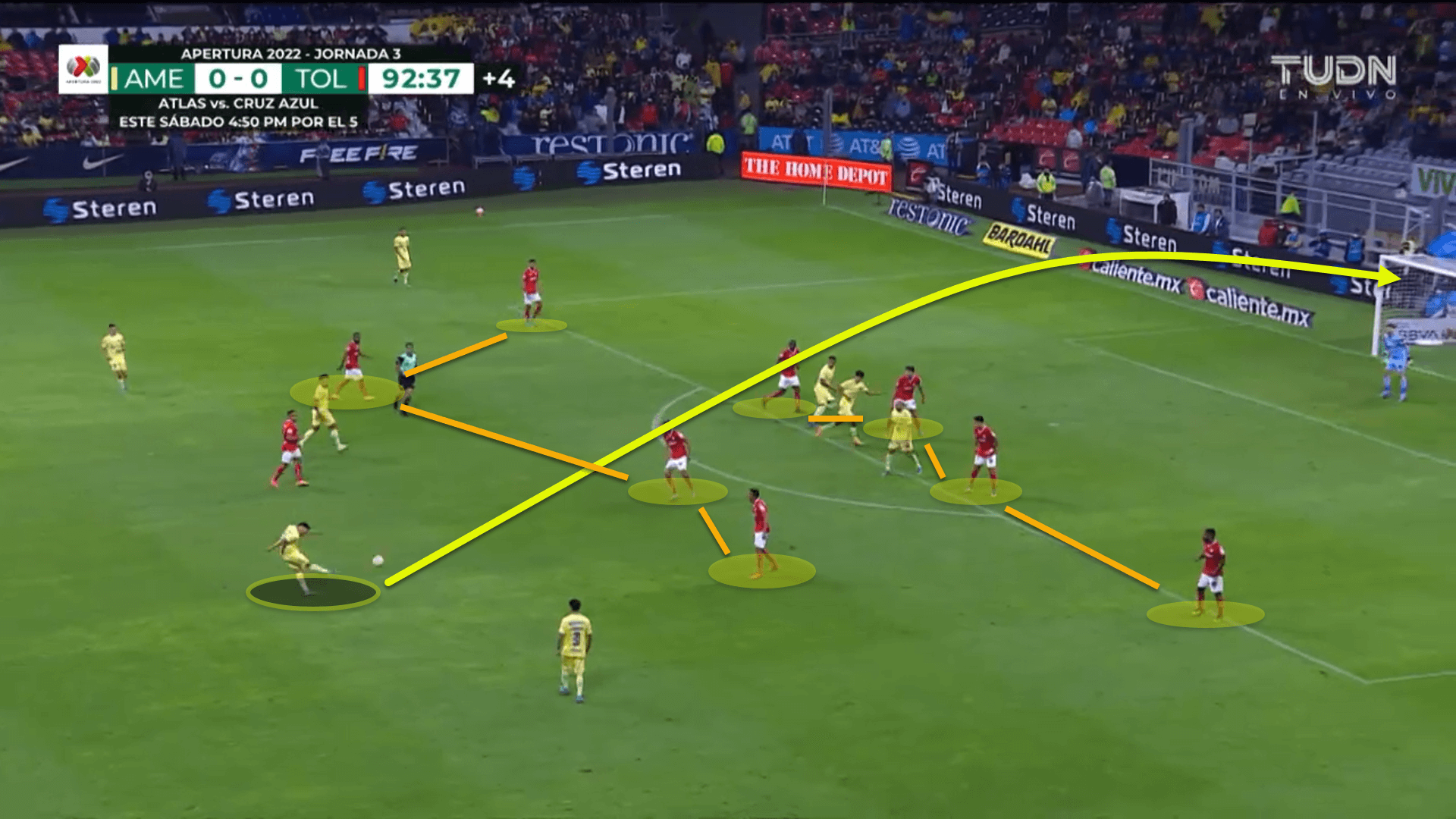
It took a 93rd-minute wonder strike from Richard Sánchez, which is displayed above, to grab a 1-0 victory for Club América in what was another night of hopeless crossing and predictability for the league leaders.
Ortiz’ downfall was believing that persistence in the same methods against a side that had proven to be worthy adversaries would be effective. They weren’t, and América bowed out prematurely from the knockout phase.
Poor build-up
Another issue that became evident for the Mexican giants during their battles against Toluca was just how poor the side were from playing out from the back.
Once more, predictability played a major factor in why Toluca were able to stifle América’s ability to progress the ball through the third.
Let’s first look at the structure that Ortiz prefers when instructing his players to pass out from the goalkeeper. Often, the centre-backs will split wide, allowing Mexican goalkeeping legend Guillermo Ochoa to have room to receive while stretching the opposition’s first line of pressure.
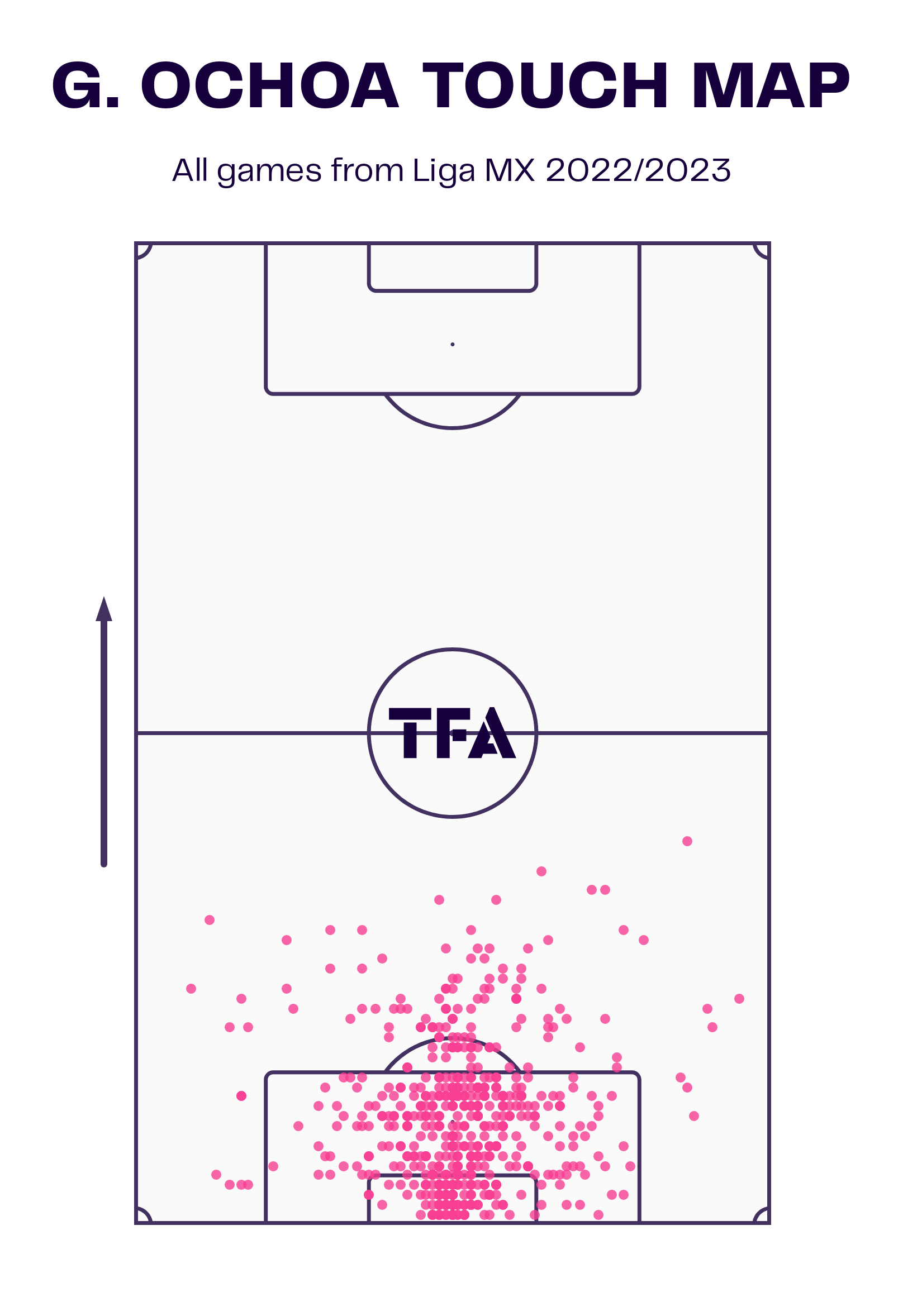
Looking at Ochoa’s touch map from this season with Club América, the veteran has had quite a lot of touches of the ball outside his own penalty.
Normally, if América are being pressed, Ochoa will sit deeper near his goal line but if the opposition drop off, Ortiz wants his keeper to be higher, allowing the team to push up, giving them passing lanes out of the first line that are closer towards the opponent’s goal.
The fullbacks push very high up the pitch too and so normally Club América’s structure from the build-up phase is a 3-1 with one pivot player dropping deep to receive out of the double pivot while the other moves forward.
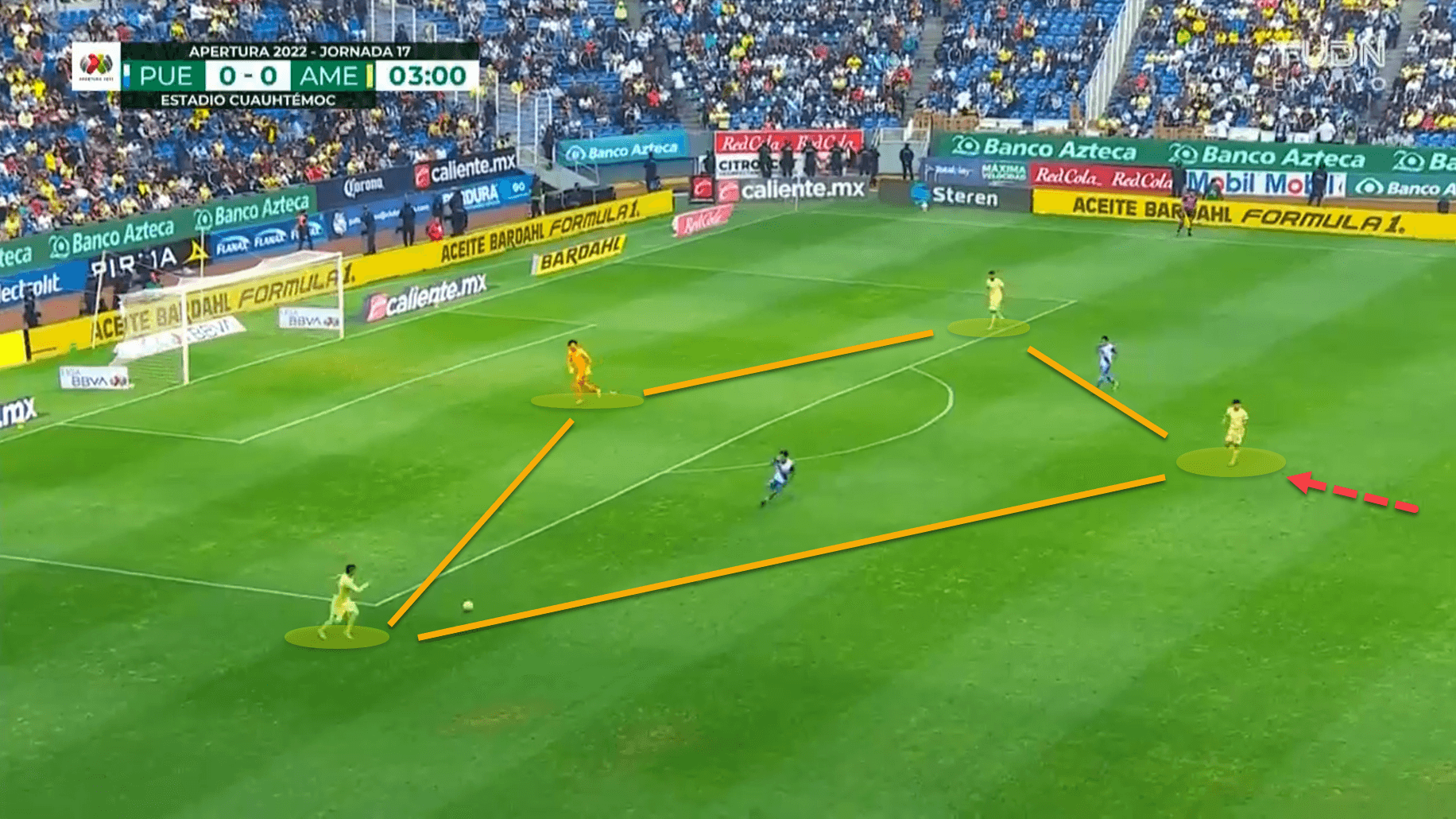
Oftentimes, this season, Club América have been given license from the opposition to play out from the back. The Passes allowed Per Defensive Action against them has been 12.15 on average per game, meaning they have been relatively unchallenged in the build-up phase.
Nonetheless, Toluca wanted to match América in the first third of the pitch by pressing high, knowing that it could cause problems, which is exactly what they did.
Ambríz’s men would close off one side of the pitch and press América’s left centre-back Sebastián Cáceres. The Uruguay international is an excellent technical player but is right-footed and struggles on his weaker foot.
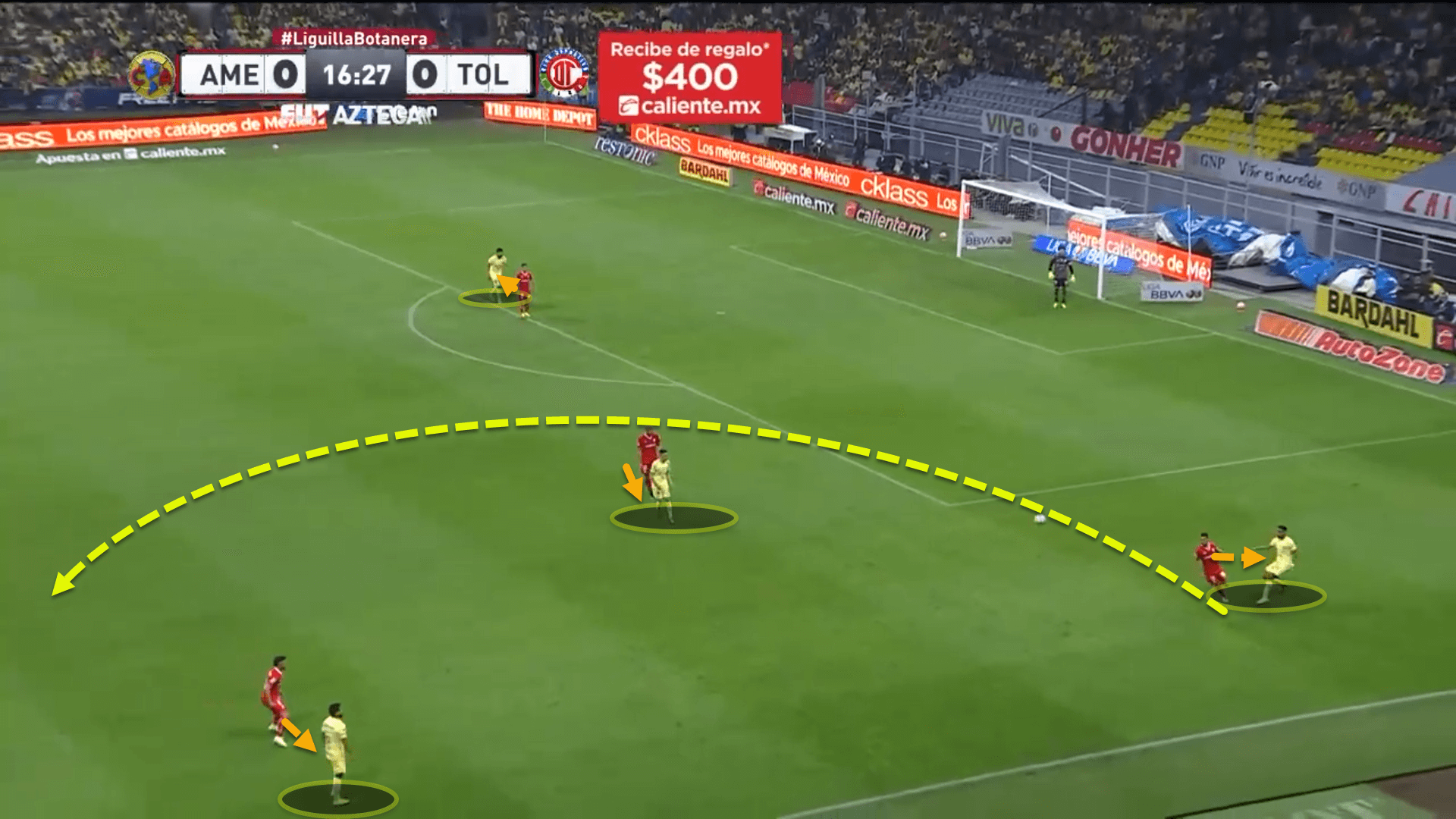
As is evident from the above image, Toluca would press the 23-year-old’s right peg, forcing him to use his left foot and so Cáceres primarily kicked it long due to being placed in these uncomfortable circumstances.
The reason this is relevant to América’s struggles is that teams play out from deep to lure the opposition to press them. Once the press is broken, they have then taken several players out of the game and are able to bare down on an unprotected backline.
América rarely managed to beat the press of Toluca, meaning the only way Ortiz’s side could look to break down their opponents was when the defending team dropped off into a low block which, as discussed in the previous section, didn’t go particularly well for them.
Lacklustre defensive block
Holding 54.55 percent of the ball per game this season in all competitions, América always wanted to be on the front foot rather than the back foot.
Unfortunately, it was their defensive displays which were the team’s downfall in the end.
Overall, the Águilas conceded an xG of 1.29 per game while conceding 1.19 goals per game in real time this season. Essentially, Ortiz’s side would allow the opposition to score at least once per match and so it was a case of outscoring their opponents through excellent attacking play which helped them to progress to the semi-finals of the Apertura.
However, as history has shown time and time again in the beautiful game, attack wins you games, defence wins you titles and América’s poor defensive record in the grand scheme of things cost them against Toluca.
One area that América excelled in across the two legs was dealing with aerials balls from their opponents. Toluca were not so keen on playing out from the back and so constantly looked to go direct to the forward line to win flick-ons.
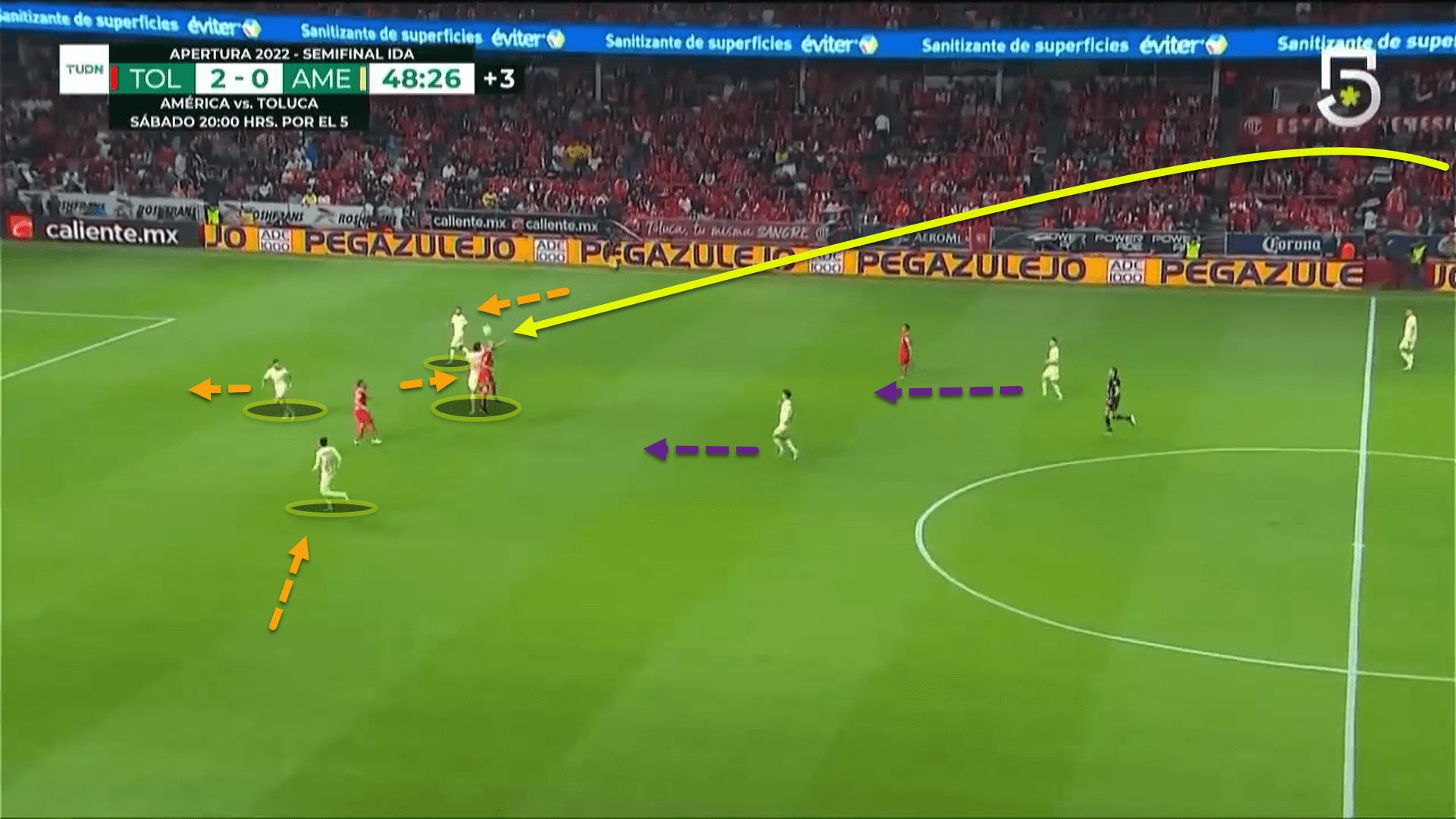
Club América dealt with this danger well. One centre-back would step out of the backline to challenge in the air. The remaining three would close the gaps, staying tight together while dropping off in order to ready themselves to run backwards in case the ball was flicked on.
Failing to deal with these long balls could have been detrimental to the team. However, the issue was actually how poorly they defended when sitting in their own low block.
During this phase, as América played in a 4-2-3-1 base formation, the number ‘10’ would push up next to the striker and create a two-man forward line, forming a conventional 4-4-2 low block.
When sitting in a low block, teams need to stay compact between the lines, cutting off passing lanes while being active to either force the opposition wide or else win the ball back. Against Toluca, América did neither of these things.
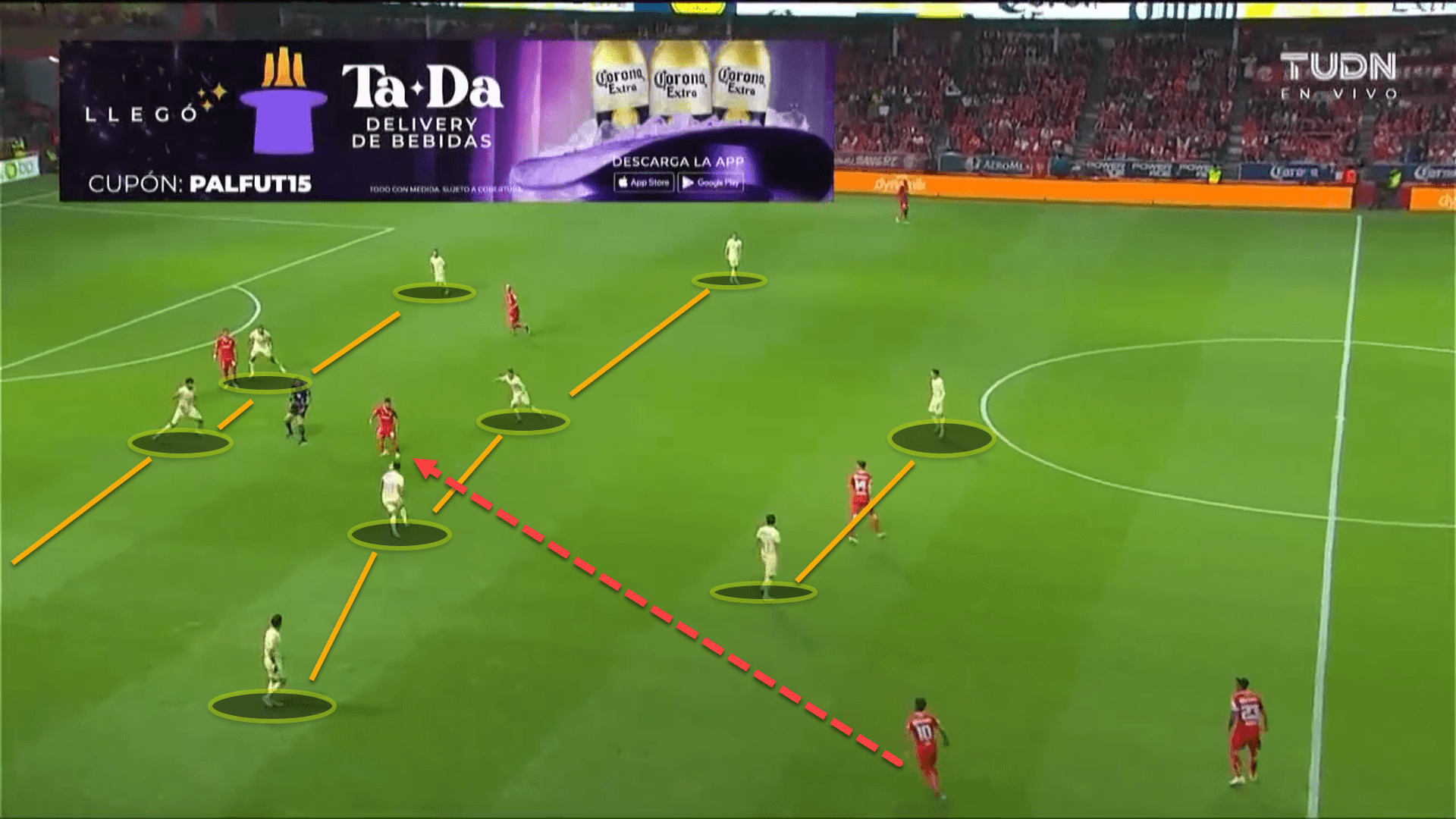
Here, the strikers have failed to apply any sort of pressure, while the midfield didn’t block any passing lanes and were carved open from numerous scenarios exactly like this, causing the team to concede an xG of 3.09 across the two semi-final legs.
Conclusion
Being lacklustre out of possession and predictable in possession was the overarching downfall of the favourites who limped out of the competition to Toluca with their tails between their legs.
Having taken over in January of this year from the former Real Madrid boss Santiago Solari, it is likely that Ortiz will be given more time at the helm in what has been a brief managerial career so far, starting in 2017.
However, with the Clausura soon to begin in Mexico, Ortiz will need to be much more adaptable with his tactical approach in games in order to bring home a title this time around.






Comments